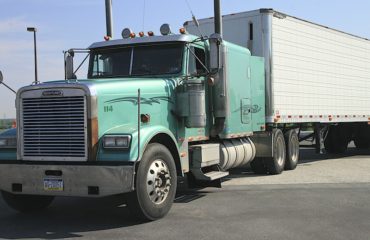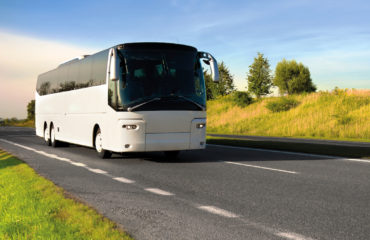Travel anywhere on the globe, and it is likely you will see a bus transporting passengers to work, to school, to home, to explore a city or even a country. Some buses are tours within a particular location; others are traveling from one city to another. In today’s society with a focused desire to get from point A to point B, it is important at times to stop and smell the flowers. Remembering where it all began and the importance of bus travel over the years allows us that opportunity.

The original 1914 Hupmobile with Greyhound President David Leach, FMCSA Administrator Anne Ferro, ABA V.P. Clyde Hart and UMA President Victor Parra.
A Time to Celebrate
Last week a recognition and a celebration of intercity motorcoach service was held at the U.S. Department of Transportation (DOT) Headquarters. “We are here this morning with the opportunity to celebrate 100 years of intercity motorcoach travel. An incredible anniversary, to think that over 100 years this industry has been literally moving America,” said Anne Ferro, Administrator, Federal Motor Carrier Safety Administration (FMCSA).
The event provided an opportunity to reflect on powerful memories and provide stories on the importance of bus travel; how bus travel built a country and changed a society. “The history of Greyhound and its partners in the intercity bus industry is truly remarkable. Through wars, depressions, boon times, the civil rights struggles and the technology revolution, Greyhound has carried hardworking Americans from city to city and from rural to urban America as they pursue their dreams,” said David Leach, Greyhound President and CEO.
One hundred years ago, it started simply enough when Carl Wickman, a Swedish immigrant and laid off miner, began charging miners 15 cents to ride his Hupmobile to and from work. There has been tremendous growth since that simple time, to present day when a vast industry transports people all over a country, and a planet. “Last year, buses carried nearly ¾ of a billion passengers in the U.S. and in Canada,” declared Honorable Victor Mendez, Acting U.S. Department Secretary of Transportation.
Next to the DOT headquarters it was possible to observe an evolving history with the original 1914 Hupmobile, and a variety of Greyhound buses that traveled the country during the past century. The display included: a 1931 Mack Bus, a 1937 Supercoach, a 1954 Scenicruiser, a modern Greyhound Bus and a Mobile Museum Bus. The museum bus had a number of vintage uniforms, signage, and a historical timeline with videos, images, and ads from the past century.
A Time to Reflect
The nearby history provided the perfect setting for reflection. “I grew up in northern New Jersey,” remembered Clyde Hart, Jr. Sr. V.P. of Government Affairs and Policy, American Bus Association, “so my introduction to a wider world starting as a teenager, was through Greyhound.” Mr. Hart continued noting that getting to a military base as a young serviceman required taking the bus, and it was with pride of the bus industry as he recalled its involvement with the civil rights movement. “I also watched as Greyhound took the Freedom Riders[1] south. I watched the Scenicruiser burn when it had the guts to take people on the Freedom Rides. It’s something that I have never forgotten and something that I want to honor today. The bus industry’s role in keeping America strong, making America live up to the ideals that we all believed in.”
Perhaps the reflections of longtime Greyhound patron Delos Smith traveling to 49 of the 50 states in the USA on Greyhound buses, provided the best glimpse into what bus travel has given America. “I started my bus travels when I was just 14 years old,” he recalled in his comments. “I went to Cody, Wyoming on a Greyhound bus. It took 126 hours to travel from New York to Cody, Wyoming, and you saw America.” During his comments, Mr. Smith took the attendees through a short history of the changes of buses, everything from adding bathrooms onto the early buses to adding WIFI on today’s buses. He noted that when riding a bus “you saw America very much, when I started as a passenger, you never missed a town. It might have been long, yes, but you really saw this country.” He wrapped up his comments by saying: “Greyhound has been a university for me…. I have seen this country in many different ways…. This is an incredibly diversified country, a fascinating country. ”
A Time for Safe Travel
While the event was a time to celebrate and reflect on the roots of this important mode of transportation, it was also a time to remember safety. Intercity bus travel is one of the safest modes of travel in the U.S. Today’s buses and drivers are held to high standards with driver training programs designed to comprehensively cover issues of fatigue, hours of service rules and random drug screening. FMCSA has also re-examined how it investigates carriers to ensure any investigation is as effective as possible and prevents crashes before they occur. While the vast majority of bus companies operate safely, a number of carriers were shut down in 2013 because of FMSCA investigations.
One way the public can learn about a bus company’s safety record is to use the SaferBus app on an iPhone or iPad. Using the slogan, Look Before You Book, the app is designed to give a traveler useful information on a bus company’s safety record, including brief information about the company, if it is allowed to operate and its safety performance for the past 24 months. The app also allows you to file a complaint about safety, service, or discrimination.
Still On the Move
One hundred years have passed since Mr. Wickland transported miners from the town of Hibbing to Alice, Minnesota. Since that time, there has been tremendous growth: growth of an industry, and growth as a country. Motorcoaches are seen in every part of the United States and beyond, providing a unique experience to see and explore a country up close. What do you say, ready for your next adventure?
What memories do you have of riding a bus? Let me know in the comments section below.
100th Anniversary Celebration of Intercity Motorcoach Service
[1] Freedom Riders were civil rights activists who rode interstate buses into the segregated southern United States in 1961 and following years to challenge the non-enforcement of the United States Supreme Court decisions which ruled that segregated public buses were unconstitutional.








